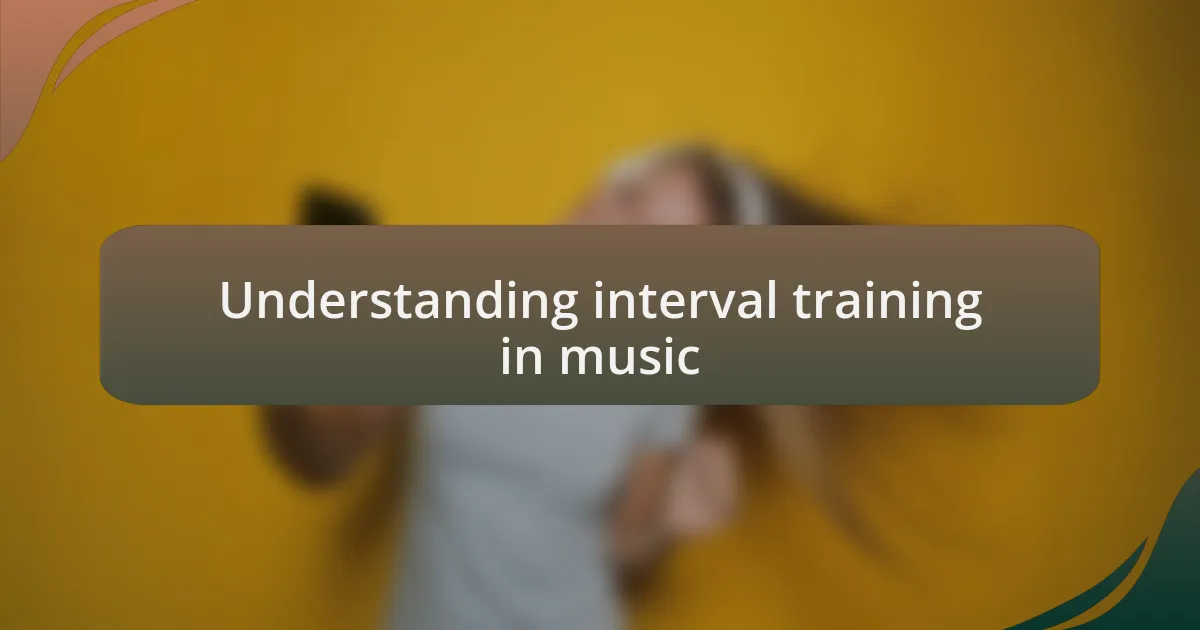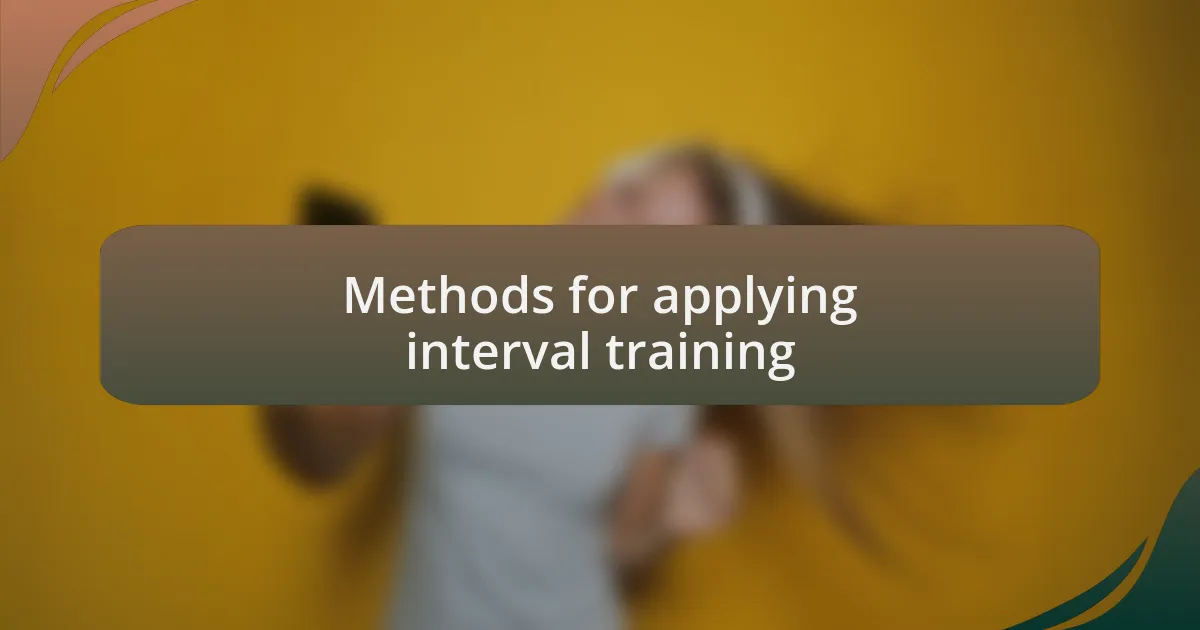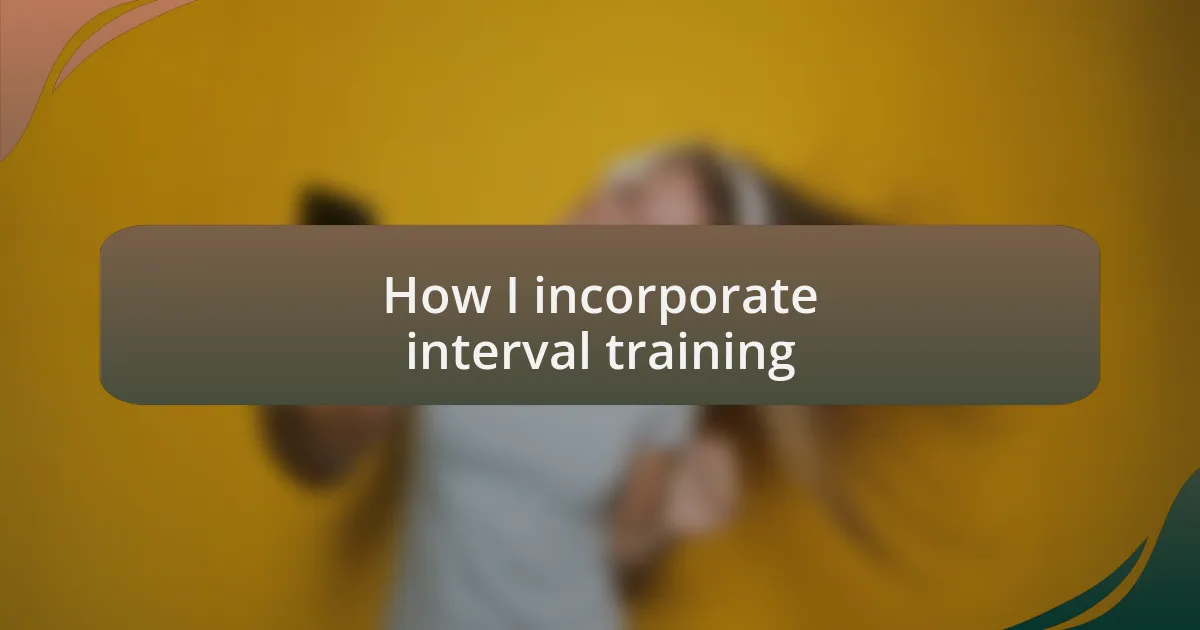Key takeaways:
- Understanding intervals is crucial for improvisation and composition in music, as they convey emotional nuances.
- Singing exercises and ear training apps are effective methods for identifying and internalizing musical intervals.
- Improvisation and collaborative exercises with peers enhance the practical application of interval training.
- Incorporating physical movement and exploring intervals across different musical genres can deepen understanding and enjoyment of music.

Understanding interval training in music
When I first delved into interval training, I found it both intriguing and a bit daunting. The concept of intervals—distances between notes—forms the backbone of music. Understanding these relationships is essential, whether you’re improvising or composing.
I recall sitting at the piano, struggling to recognize the difference between a major third and a minor third. It’s those moments of confusion that turned into breakthroughs. Have you ever had that “aha!” moment when everything clicks into place? I remember the joy of hearing how those intervals created tension or resolution in the music I played.
Through interval training, I not only learned to identify pitches but also to feel the emotional weight they carried. Each interval evokes a distinct feeling—like the bittersweet quality of a minor sixth versus the happy brightness of a major sixth. It’s a personal journey where theory becomes an emotional language, allowing you to connect deeper with the music you create.

Methods for applying interval training
One effective method I’ve used to apply interval training is through singing exercises. I often start by singing scales and then seamlessly incorporate intervals, like thirds and fifths. As I progress, I might ask myself, “How does this interval make me feel?” This self-reflective approach deepens my understanding and helps me internalize the sound of each interval.
Another technique that has yielded great results for me is using ear training apps. These tools often present intervals for me to identify by ear, which replicates a classroom environment wherever I am. I remember the first time I correctly identified a perfect fourth—I felt a rush of excitement. It solidified my belief that consistent practice with these methods can truly sharpen my musical ear.
In addition to these exercises, I’ve found great value in analyzing songs that prominently feature intervals. By picking apart my favorite pieces and identifying significant intervals within them, I bring the theory to life. Have you ever noticed the crucial role intervals play in defining a song’s character? For me, exploring this aspect enriches my appreciation and enhances my own creative expressions.

How I incorporate interval training
One of my favorite ways to incorporate interval training is through improvisation. I often find myself at the piano, experimenting with melodies that focus on specific intervals like sixths or sevenths. It’s fascinating to see how a simple shift in interval can evoke entirely different emotions in the music. Have you ever tried improvising with intentional intervals? You might be surprised by how quickly you can expand your musical vocabulary.
In small group settings, I encourage peer-to-peer exercises where we create short melodies using specific intervals. This collaborative approach not only keeps learning engaging but also fosters a supportive environment. I remember one session when a fellow student came up with a melody built entirely on minor thirds. It was amazing to hear how the chosen interval transformed the piece’s mood, making it haunting yet beautiful. How have your peers influenced your understanding of intervals?
Additionally, I’ve had great success in linking interval training with familiar songs. By singing or playing parts of songs that emphasize specific intervals, I’ve been able to make theoretical concepts more tangible. I still recall the excitement of discovering how the opening of “Here Comes the Sun” features a major seventh. This connection to familiar music leaves a lasting impression and solidifies my grasp of intervals in a practical context. What songs have helped shape your understanding of musical intervals?

Tips for effective interval training
When it comes to effective interval training, I find that using a range of tools can enhance my learning experience immensely. I often turn to apps and online resources that focus on ear training, allowing me to hear and identify intervals in real time. This interactive approach not only sharpens my listening skills but also adds an element of fun—who doesn’t enjoy a good challenge? Have you found any specific apps that resonate with your learning style?
Another technique that works wonders for me is integrating physical movement into my practice. I’ve experimented with clapping or stepping out intervals, which really helps to internalize the sounds. The bodily movement creates a kinesthetic connection to the music; it’s almost like dancing through the notes. This method has turned what could be a tedious task into an engaging experience. How do you incorporate physicality into your musical practice?
Finally, I make a habit of regularly revisiting intervals in varied contexts. For instance, I’ll take a simple interval and explore it through different genres—playing a major third in a jazz setting versus a classical one. This comparison not only broadens my understanding but also allows me to appreciate the versatility of intervals in different musical frameworks. Have you ever played around with an interval in multiple styles? The transformations are truly enlightening.